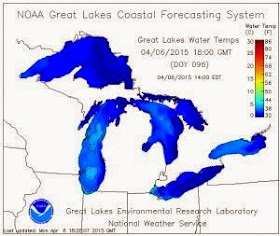This chart of the Great Lakes shows how cold lake
temperatures remain, despite recent warm weather. Chart courtesy of NOAA
APRIL 6, 2015
CLEVELAND, OHIO
On the two-year anniversary of a tragic boating accident
near Sandusky, Ohio, the U.S. Coast Guard is reminding Great Lakes boaters who
may be thinking about venturing out on the area’s lakes and rivers to consider
that the water remains dangerously cold despite warming air temperatures.
At the start of spring each year, Great Lakes Coast Guard
crews respond to dozens of cold water accidents involving boaters lured to the
lakes by warm air temperatures, and these frequently result in hypothermia and
death.
April 6, 2013, a father and his 12-year-old daughter went
kayaking in Sandusky Bay. A friend reported them missing the following morning
when the pair failed to return. They were last seen wearing sweatpants and
hoodies with no life jackets. Later that day, searchers found their kayaks
filled with water and debris, but no sign of the two people. Tragically, on the
morning of April 20, 2013, Lake Erie boaters discovered their bodies.
An autopsy performed by the Erie County Coroner’s Office
revealed both died from drowning. It is unknown how long the pair was in the
water before they died.
“Many people don’t realize cold water deaths are often a
result of drowning, not hypothermia,” said Mike Baron, the recreational boating
safety specialist for the Coast Guard 9th District in Cleveland. “The natural
reaction to sudden cold water immersion is to instantaneously gasp for air, and
most people inhale water at that time, increasing their risk of drowning.”
The air temperature in Sandusky reached a high of 55 degrees
April 6, 2013, but the water temperature was still frigid at just 39 degrees.
Conditions there Monday are similar; the air temperature is
forecast to peak at 59 degrees but the water temperature is still only 38
degrees.
“Though the air is warm, the water is still very cold, and
in the event of an accident, boaters who enter the water can drown or become
hypothermic within minutes,” said Baron. “Hypothermia is dangerous because it
affects the body’s core temperature, and even mild cases of hypothermia affect
your physical and mental abilities, and increases the risk of accidents. Severe
hypothermia causes loss of consciousness and may result in death. Cold water is
especially dangerous because loss of body heat occurs 25 times faster in cold water
than in cold air.
“All boaters should dress for the water temperature, not the
air temperature.”
Here are five tips to help spring boaters safeguard their
lives and those of their loved ones:
1. Dress for the water temperature, not the air temperature. Even
in sunshine and warm air, if you fall in the water, your body will respond as
if you were standing outside naked in 40-degree weather. When someone falls
overboard, his or her core temperature begins to drop within 10 to15 minutes.
The water doesn’t have to be icy – it just has to be colder than the victim to
cause hypothermia. Even worse, our body’s first response to cold water
immersion is to instantaneously gasp for air, but chances are that you’ll end
up with a mouthful of water and be on the path to drowning. We recommend
paddlers wear a dry suit in water temperatures less than 72 degrees Fahrenheit.
2. Have and use the proper safety equipment. Don’t
just have a life jacket on board; wear it. The importance of this tip is
amplified in cold water because the heat loss will rapidly impair your ability
to use your fingers. Also, consider investing in a personal locator beacon.
Once activated, PLBs will transmit your exact location to rescuers, essentially
removing the ‘search’ from search and rescue, saving critical time during a
response.
3. Don’t drink and boat. Operating a boat under the
influence of drugs or alcohol is illegal. Furthermore, drinking increases the
risk of hypothermia because, contrary to the popular belief that alcohol
provides a “liquid jacket,” alcohol accelerates heat loss by expanding blood
vessels.
4. Be ready for the environment. Life-threatening weather
can develop quickly. Boaters should invest in a VHF-FM marine radio, which
receives regular marine weather forecasts and warnings. They should learn the
indicators of developing weather. And they should immediately seek safe harbor
whenever weather warnings are issued. A radio will also help you call for help
more reliably than a cellphone when you’re on the water. Additionally, a
personal locator beacon can immediately alert responders to your distress,
significantly increasing your chances of rescue. Tell others where you are
boating and when you will return to add an additional level of safety to your
outing.
5. Be a responsible boat owner. You can ensure you stay
out of the water by learning and adhering to safe boating regulations and the
Rules of the Road and making sure your boat is ready for the season. Keep a
sharp lookout for other boaters and avoid excessive speed. Seek out
available boating education classes and vessel
safety checks, which are often offered at low or no cost by local Coast
Guard Auxiliary flotillas. Free basic boating courses also are available
online. Updating your registration contact information and registering and
labeling your paddle craft with an Operation Paddle Smart sticker streamlines
the early stages of the search and rescue process.
